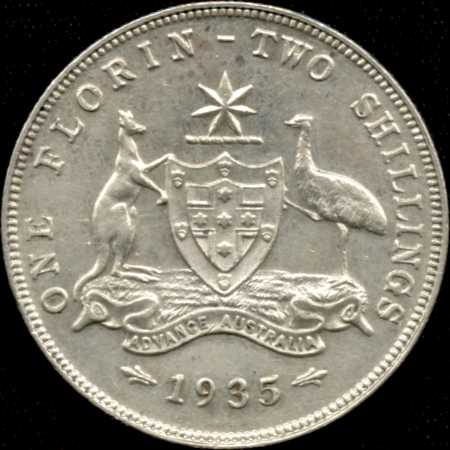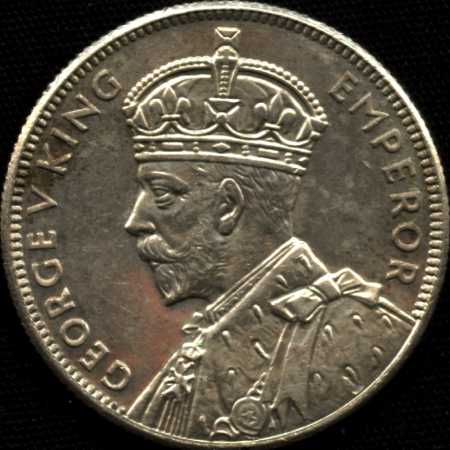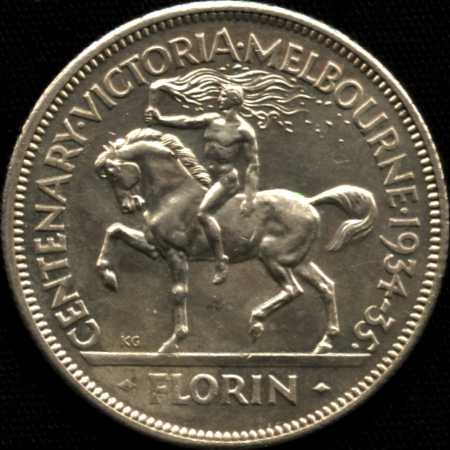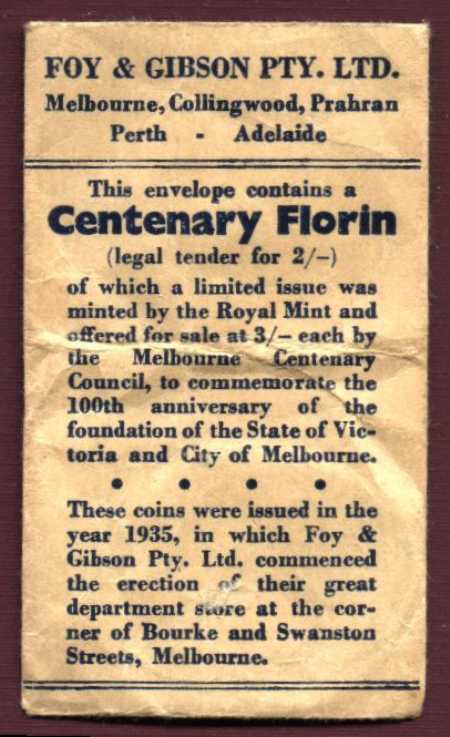
|
|
|
|
| |
|
Designation |
|
|
|
Mint |
|
|
|
Mint mark |
|
|
|
Mintage |
|
|
There are no documented varieties of the standard issue 1935 florin.
Despite its low mintage, this coin (i.e. the standard one) is fairly easy to
obtain.
The commemorative florin issued in 1935 to mark the centenary of Melbourne was
the first Australian mint product to sold at a premium over its face value. 75,000
of these coins were struck and were offered for 3/- each. In the aftermath of the
Great Depression, the idea of paying 3/- for a 2/- coin did not sit well with Australian
people and 21,000 of these coins were later melted down, leaving just 54,000 in
circulation.
Although the Melbourne Centenary florin is a very scarce coin, its very distinctive
design and premium price made it highly collectible and many were set aside and
or were pulled from circulation very early. In addition, the Melbourne retail shop,
Foy and Gibson, gave away a florin with every suit it sold in 1935. It also gave
away florins in change at face value to its customers. The collectability of the
coin meant that many were never circulated; of the several thousand specimens in
existence many are of very high grade. Mint rolls are known to have existed at least
until 1999. The result of all this is that the price of very high-grade Melborne
Centenary florins is actually lower than the price of the standard issue coin in
similar condition.
 |
F35M.2A |
 |
F35M.4C obverse |
 |
F35M.4C reverse |
 |
Paper envelope in which Foy & Gibson presented Melbourne Centenary florins to
some of its customers. |
An article titled "Collector or Numismatist" by Alan H. Collis in the
July 1971 issue of The Australian Coin Review dealt with the history of the coin
itself and of the early settlements on Port Phillip Bay. What follows is an excerpt
from that article and is reproduced here with the permission of Australasian Coin
and Banknote Magazine, the current copyright holder.
|
A search through the daily newspapers of the period provides
us with some interesting information. On 21 June 1934 we read in the Argus: Centenary Florins to be StruckOn 15 February 1935 the Argus printed the following: Centenary Florin Sales are DraggingThen on 17 May 1935 there appeared: Centenary Florins bought by American CollectorsThe following was printed on 22 June 1935: Improved Demand on FlorinsA small footnote reads: A company has an option on 30,000.Presumably this company was Foy and Gibson. The article continues: In the last few days there has been an increased demand from the public but at this date 33,000 still remains to be sold.The following information, although not from the newspaper of the day, is also relevant. On the assumption that this figure of 33,000 is after Foy
and Gibson received their florins, a further 12,000 would therefore have been sold
in order to leave the quantity of 21,000 for remelting. As far as I can establish, the coins were mainly available
through the Centenary Committee's outlet at the Melbourne Town Hall and through
the Foy and Gibson organisation. The State Savings Bank of Victoria also distributed
the coins from selected country branches of the bank including all the larger towns. The 30,000 florins acquired by The Foy and Gibson organisation
were purchased at three shillings each, placed in small paper bags especially prepared
for the purchase, and issued to Foy's customers throughout Australia, at face value,
as change from their purchases. Thus Foy's advertising scheme cost them one shilling
per coin. Today, Centenary florins in Foy's bags are sought after by collectors. ... The obverse was designed by Percy Metcalf and is the only
design by this artist in the Australian Commonwealth series, although this same
design was used on Rhodesian, New Zealand and Fijian coinages. The horse and rider
reverse was designed by George Kruger Gray, well known amongst Australian coin designers.
The horse represents the last century which was one in which horses played a very
important part in exploration, settlement, cultivation and development of every
industry in Victoria. The raised fore-hoof indicates no limit to future progress.
The nude rider represents young Victoria grown to manhood and the torch is a symbol
of progress and enlightenment. And what does the Florin commemorate? It commemorates the
Centenary of the first permanent settlement within Victoria, firstly at Portland
Bay in 1834, and secondly, at Melbourne in 1835. So therefore the significance of
this coin is that it identifies itself with the very reason for our being here and
our existence in our City of Melbourne. So, also, the reason for the words 'Victoria'
and 'Melbourne' on the coin, also the double date of 1934/35. |